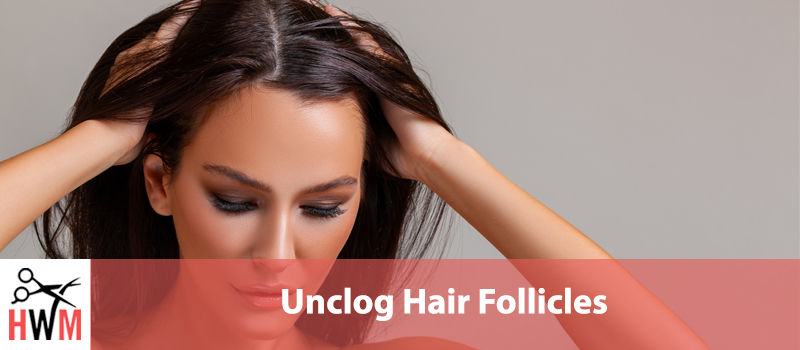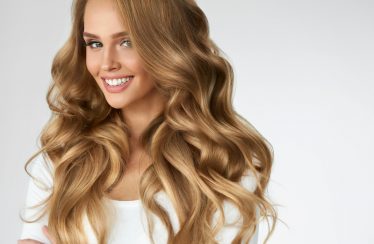Millions of people experience clogged hair follicles at one time or another. Clogged hair follicles are often the source of mysterious itching or inflammation that causes you to scratch incessantly at your head all day.
Even worse, clogged hair follicles frequently lead to excessive dandruff and greasy hair that is hard to style. Greasy hair looks terrible, too. Clogged hair follicles are bad for your scalp health and bad for your aesthetic. In other words, no one wants to have them for long.
Fortunately, there are lots of ways to unclog your hair follicles depending on what’s clogging them in the first place. We’ll go over the most common and easiest methods to unclog your hair follicles in this comprehensive guide.
- What Are Hair Follicles?
- How Do Hair Follicles Work?
- How Do They Become Clogged?
- Methods to Unclog Hair Follicles
- Homemade Haircare
- Improving Hair Health
What Are Hair Follicles?
There are some misconceptions that some people hold regarding what exactly a hair follicle is. Contrary to many guides about hair health, your hair follicles are not your hair strands themselves or hair roots.
Instead, hair follicles are the small dermal organs from which your hair strands grow out of. Hair follicles don’t just act as reservoirs for hair to emerge from, however.
In fact, hair follicles have lots of responsibilities. For starters, hair follicles are responsible for regulating hair growth rates. They do this by negotiating the interactions between your immune system, certain neuropeptides that make up the building blocks of hair strands, and your hormones.
Hair follicles also anchor hair to your skin. Each hair strand has a small bulb that fills the base of a hair follicle, keeping it in place even under stress. This bulb is where new hair cells replenish old hair cells and deliver nutrients through the hair shaft’s length.
Essentially, hair follicles provide for the growth and repair of your hair strands.
Because hair follicles regulate the hair production process, they’re the organs responsible for the different lengths and thicknesses of hair across your body. Your head hair isn’t exactly the same as the hair of your eyebrows or on your skin, for instance.
Hair follicles are made up of several smaller parts. These parts are:
There are even more technicalities to dive into, but the above components are the major aspects of hair follicles to be aware of.
In addition, hair follicles have different shapes depending on a person’s ethnicity. Some ethnicities have elliptical follicles that produce straight or wavy hair, while others have curvier follicles that produce curly hair.
How Do Hair Follicles Work?
Hair follicles play key roles in the growth and repair of your hair. Hair growth and repair is normally accomplished through cycles with various phases.
Anagen Phase
In this phase, hair roots grow and cells at the base of each hair strand divide rapidly. This added mass causes the hair to grow thicker and taller over time. Typical hair growth rates average about 1 cm every 28 days.
In addition to the above rate, your hair strands may grow faster or slower depending on their type. The type is regulated by the hair follicle. For instance, scalp hair strands remain in the anagen phase for between two or seven years depending on your genetics.
At the end of this phase, a hormone shift causes the follicle to change and initiate the next space.
Catagen Phase
This phase is a transitory period. This signals the body to stop supplying a particular hair strand with fresh stem cells for production. This lasts for between two or three weeks. During this time, the hair strand of the follicle changes to become a “club” hair. The hair follicle responsible for that hair strand will attach to the shaft.
Telogen Phase
Hair follicles rest when they reach this phase. Over time, hairs attached to these follicles will eventually fall out once they stop receiving more nourishment. Average hair loss rates are around 50-100 hairs from a healthy scalp per day.
How Do They Become Clogged?
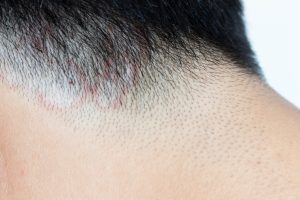
Your hair follicles can become clogged due to a variety of reasons. The most common of these revolve around your scalp’s sebum production.
Sebum Overproduction
Normally, sebum production occurs at a natural rate. Sebum is necessary for scalp and hair follicle health in normal amounts because the waxy substance prevents moisture from evaporating from your skin. It also protects your hair shafts and follicles from physical damage incurred from everyday wear and tear.
But some people are genetically predisposed to produce more sebum than is normal. This can eventually lead to the waxy substance building up over time and clogging your hair follicles once they discard old hairs.
Bacterial or Fungal Infections
Sebum overproduction can also cause bacterial or fungal infections that take root in your hair follicles. These bacteria or fungi act as physical blockers and feed off of the energy in your sebum or in the other oils naturally produced by your scalp. These types of infections can be particularly irritating or itchy.
Dandruff Build-Up
Similarly, people who have genetic predispositions for heavy dandruff may also find that dead skin cells build up in their follicles over time. This can occur due to having a dry scalp or an inflamed scalp from the use of certain hair products or environmental issues. Dandruff is normally caused when dead skin cells are piling up more than usual.
Hair Styling Resins
Finally, those who use frequent hair care or hair styling products with many synthetic compounds may find that their follicles clog more than average. Many synthetic chemicals or ingredients are not easy to dissolve with common cleaning techniques or may not wash out during your regular shower. This often leads to follicle clogging and other health issues down the line, especially if some of the synthetic elements are absorbed by your scalp and make it into your bloodstream.
It’s also a poor idea to mix different hair styling products if you know that your scalp is more sensitive than average. Hairstyling products that mix together can become particularly hard to dissolve or eliminate.
Furthermore, you must wash your hair thoroughly every time you use a hair styling product. Leaving hair styling products in your hair overnight or for long, unbroken periods of time will result in clogged follicles on even the healthiest scalps. Many hair styling products become harder or thicker the longer they rest in your hair.
Hair follicles can be clogged in these ways and more. For some, it’s a lifetime condition while for others it may be temporary. But everyone can treat clogged hair follicles with several methods.
Methods to Unclog Hair Follicles
Hair follicle treatments all revolve around the same basic objective: remove whatever is blocking your hair follicles so they can continue producing new, healthy hair unimpeded. The only difference between the methods is how they get rid of the blocking substances.
Shampoos and Commercial Solutions
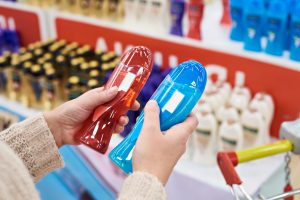
The most basic and common hair follicle unclogging solution is to use a good shampoo. Not any shampoo will do, especially since some shampoo brands make use of the same synthetic compounds that might lead to clogged follicles in the first place.
But one of the primary purposes of all shampoo products is to eliminate excessive hair oil and dead skin cells. In other words, shampoo cleanses your scalp and hair strands of both foreign particles and the buildup of natural particles.
So shampoos that have natural ingredients that don’t stand a chance of irritating your scalp or clogging your follicles are a great idea. Many of the ideal products for unclogging hair follicles will be listed as “noncomedogenic”. This simply means that the included ingredients will not clog your pores or follicles due to their chemical composition.
You should rub your shampoo deep into the pores of your scalp so that the dissolving formula can attack excessive sebum and dead skin cells.
Common natural ingredients found in the best shampoos include:
Meanwhile, you should avoid ingredients such as:
If you think that your clogged follicles are a result of a bacterial or fungal infection, it’s a great idea to purchase an antibacterial shampoo. These shampoo products will have special ingredients or chemicals that are designed to get rid of bacterial issues. In many cases, these shampoos are your only solution since infections can dig deep into the skin of your scalp and avoid regular cleaning products.
Conditioners
For those suffering from dandruff, conditioners will be a great pick. Certain conditioners can prevent your scalp from producing excessive sebum or dead skin cells by increasing its moisturization abilities. Most dandruff is caused due to a dry scalp, either from your environment’s low humidity or your genetics. Conditioners can alleviate or eliminate this issue entirely.
Furthermore, conditioners can provide your hair follicles and shafts with the nutrients they need to grow quickly and strongly. Hair follicles that already have a hair filling their space aren’t at risk of becoming clogged like those that are currently empty.
Try to find non-comedogenic conditioners if you decide to use commercial products to treat your clogged follicles.
Clarifying Shampoo
Clarifying shampoos are one final commercial solution that is specialized for removing dead skin buildup and eliminating clogging materials. These shampoos are frequently used by frequent hairstylists. They possess formulas with lots of dissolving chemicals or ingredients and are excellent for getting rid of any synthetic resins or oils in hair.
Clarifying shampoos are very rough on the scalp and hair follicles, however. For this reason, you should only use a clarifying shampoo once or twice a month at most. These shampoos have a tendency to dry out your hair and scalp, as well. We’d recommend that you use a moisturizing conditioner in conjunction with such a shampoo if you decide to go this route.
But clarifying shampoos will almost certainly get rid of any buildup sebum or dead skin cells that might have piled up over the last weeks or months. They’re the closest thing to a reset button that your scalp will enjoy. Just don’t use them as frequently as normal shampoo unless you want to irritate your scalp in a totally different way.
Homemade Haircare
Sometimes commercial products can’t do the trick or aren’t appropriate for eliminating your follicles’ clogging substance. In these cases, homemade remedies are a worthwhile alternative that often have just as good or better results than even the most expensive shampoos.
Salicylic Acid Peel
For starters, consider a salicylic acid peel. Salicylic acid is a compound used in many shampoos and facial cleansing products. It’s a weak acid that excels at eliminating dead skin cells, so it’s often used to treat dandruff or exfoliate the skin. This can also be exploited to get rid of excessive hair oil or dead skin cells.
Creating your own salicylic acid peel is easy. All you need to do is purchase a small amount of both the acid and coconut oil. You can usually find both ingredients at a pharmacy or a small grocery store.
Simply apply a generous amount of coconut oil to your scalp and spread it thoroughly across your head. The coconut oil acts as a moisturizer to prevent the salicylic acid from drying your skin out and exacerbating dandruff. The coconut oil should sit on your scalp for about 30 minutes.
Next, use a small dropper to apply very small amounts of salicylic acid to your scalp. Let that sit for 10 minutes. It should mix with the coconut oil and form a light, semitransparent peel. This can be removed from your head and you should see gunk or oil come off with it. It’s recommended that you take a shower after using such a peel. Adding a moisturizing conditioner after the fact is always a good idea.
Essential Oils
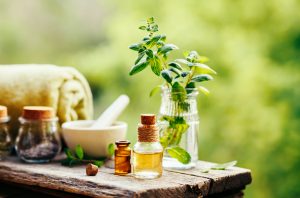
Essential oils have long been used as scalp treatments. Even before hair and the scalp were understood in a scientific context, ancient civilizations have relied on essential oils and blends to moisturize and nourish the scalp to improve hair growth and reduce dandruff. In fact, there is some evidence to suggest that essential oils can even fight off hair loss to a limited degree.
But you can’t simply apply undiluted essential oils to your scalp. Regular essential oils are quite intense and can damage the skin if you apply them without mixing them well with a designated carrier oil. This involves mixing a few drops of your chosen essential oils with a carrier oil into a blend.
You then rub the blend into your scalp and let it sit for between 20 minutes to a half-hour before washing it out.
Some of the best essential oils for hair include:
You should mix these oils with a good carrier oil, such as:
Tea tree oil deserves a special mention. This oil has antibacterial and antifungal properties. If your hair follicles are being clogged due to infection, coming up with an oil blend that includes tea tree oil is a surefire way to fight off said infection.
These oils don’t necessarily unclog your follicles by themselves. But they will result in a healthier scalp and can stop it from producing too much sebum or drying out. Try this method if your scalp’s follicles are primarily being clogged by dandruff or producing sebum from frequent irritation.
Make Your Own Shampoo
Finally, you can make your own non-comedogenic shampoo if you can find a commercial product that suits your purposes. The actual formula for the shampoo can vary based on the ingredients you have available. But your shampoo should rely primarily on sodium bicarbonate (or baking soda) and apple cider vinegar.
2 tablespoons of apple cider vinegar should do the trick when mixed with a single teaspoon of baking soda. These can further be mixed with a few drops of a favorite essential oil to add a fragrance or moisturizing abilities. Whatever you add to the primary to ingredients, mix everything in a half-pint glass with warm water.
After stirring the ingredients thoroughly, let the homemade shampoo rest for about a half-hour. This gives the apple cider vinegar and baking soda a chance to fully mix and react with one another.
After the stage, the shampoo is ready to go. It’ll be much thinner than most other commercial shampoo products, but it should work perfectly with a regular showering routine. Be sure to rinse everything out after you’ve scrubbed your scalp with the solution.
Improving Hair Health
Beyond directly on clogging your hair follicles, you can focus on improving your hair or scalp health. A healthy scalp is far less susceptible to bacterial infections or sebum overproduction. Health hair grows more quickly and fills up your hair follicles, making them impossible to clog.
Essentially, taking steps to improve the health of your head can go a long way toward lowering your chances of experiencing clogged follicles in the first place.
Showering in the Morning

You should always take a shower in the morning if your schedule permits it. Your scalp does not produce sebum at random intervals. Instead, most of your sebum production occurs during the nighttime hours while your body rests and your scalp prepares for another day of wear and tear.
Taking a morning shower will rinse away excessive sebum and dead skin cells before you go about your daily activities. This will result in less daytime irritation and inflammation, as well. Keeping a regular shower routine is critical to good hair help regardless of when you do it. Moving your showering time to the morning is simply more effective than taking a shower in the evening for the purposes of follicle unclogging.
Lower Shower Temperature
You can prevent damage to your follicles and scalp as a whole by lowering the temperature of your daily showers. Many people enjoy the feeling of scalding hot water cascading down their back and head.
But this can cause unforeseen damage to your hair follicles or scalp and make them more susceptible to bacterial infection. Alternatively, your scalp may produce excessive sebum as a response to the high temperatures of your showers.
Taking lukewarm or cool showers can do just as good a job of cleaning you as hot showers can. But these types of showers won’t accidentally damage your scalp or follicles in the process.
Diet
Your diet is also important when it comes to follicle health. Many people who overproduce sebum in their scalp also have poor diets. Your body takes what you eat and uses it to produce what it can. Therefore, eating lots of fatty or oily food will result in fewer essential building blocks for new hair. Your scalp may overproduce sebum to protect the hair that you do have.
Eating more natural foods and fruits and vegetables are great ways to boost your hair and scalp health in general. Not only will this cause your scalp to stop overreacting and producing too much sebum, but it will also cause your hair to grow stronger and thicker than before.
This won’t override your genetic predisposition to baldness or thin hair, of course. But a healthy diet is always a good idea no matter what you are trying to accomplish.
